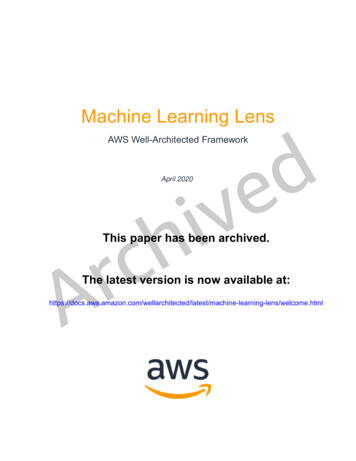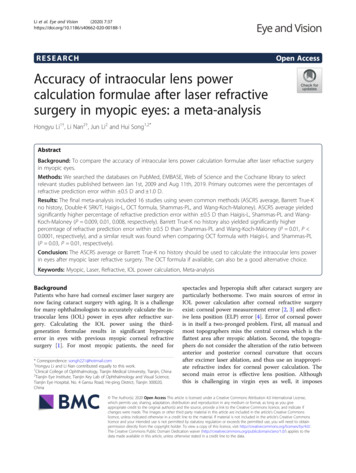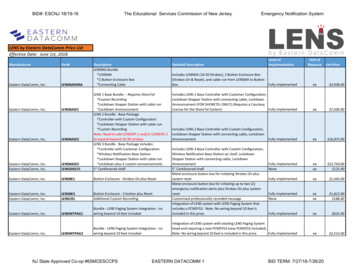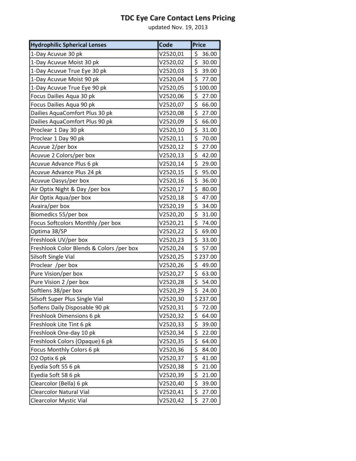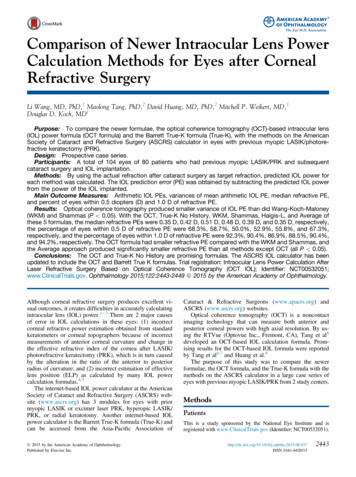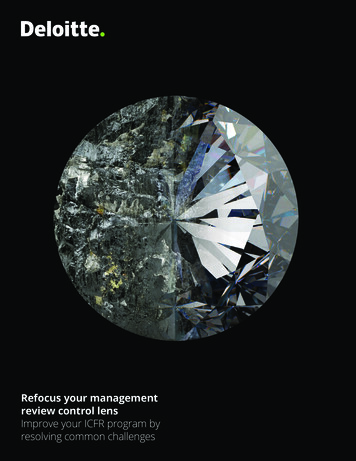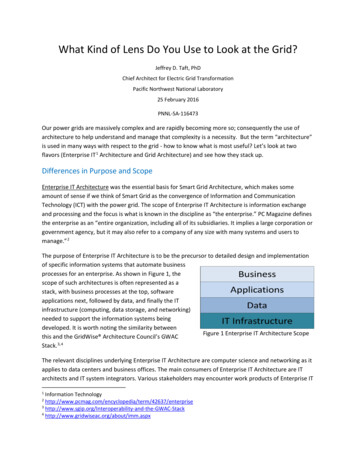
Transcription
What Kind of Lens Do You Use to Look at the Grid?Jeffrey D. Taft, PhDChief Architect for Electric Grid TransformationPacific Northwest National Laboratory25 February 2016PNNL-SA-116473Our power grids are massively complex and are rapidly becoming more so; consequently the use ofarchitecture to help understand and manage that complexity is a necessity. But the term “architecture”is used in many ways with respect to the grid - how to know what is most useful? Let’s look at twoflavors (Enterprise IT 1 Architecture and Grid Architecture) and see how they stack up.Differences in Purpose and ScopeEnterprise IT Architecture was the essential basis for Smart Grid Architecture, which makes someamount of sense if we think of Smart Grid as the convergence of Information and CommunicationTechnology (ICT) with the power grid. The scope of Enterprise IT Architecture is information exchangeand processing and the focus is what is known in the discipline as “the enterprise.” PC Magazine definesthe enterprise as an “entire organization, including all of its subsidiaries. It implies a large corporation orgovernment agency, but it may also refer to a company of any size with many systems and users tomanage.” 2The purpose of Enterprise IT Architecture is to be the precursor to detailed design and implementationof specific information systems that automate businessprocesses for an enterprise. As shown in Figure 1, thescope of such architectures is often represented as astack, with business processes at the top, softwareapplications next, followed by data, and finally the ITinfrastructure (computing, data storage, and networking)needed to support the information systems beingdeveloped. It is worth noting the similarity betweenFigure 1 Enterprise IT Architecture Scopethis and the GridWise Architecture Council’s GWACStack. 3,4The relevant disciplines underlying Enterprise IT Architecture are computer science and networking as itapplies to data centers and business offices. The main consumers of Enterprise IT Architecture are ITarchitects and IT system integrators. Various stakeholders may encounter work products of Enterprise ITInformation out/imm.aspx12
Architecture but its purpose is largely to inform the next level of stepwise refinement toward detaileddesign. The focus on information exchange drives enterprise IT architecture development and leadsnaturally to an intersection with Interoperability standards.Grid Architecture is defined as the highest level description of the complete grid, organized in a way thatsupports reasoning about the whole grid. It defines the components, structure, behavior, qualities,properties, interfaces, and essential limits of the entire power delivery system. The focus of GridArchitecture is grid structure and structural properties; the scope is the entire set of entities,components, processes, and structures associated with the grid. 5The purpose of Grid Architecture is to help stakeholders think about the overall shape of the grid, itsattributes and limits, and how the parts interact, in order to help manage complexity (and thereforerisk), to assist communication among stakeholders around a shared vision of the future grid, to identifyand remove barriers and define essential limits, to identify gaps in theory, technology, organization,regulation, and to provide a framework for complex grid-related development activities. As shown inFigure 2, structure includes not just the physical grid but also industry structure (including business andmarket structure), regulatory structure, sensing and measurement, protection and control networks andcoordination frameworks, communications, and convergent systems such as water, natural gas,transportation, and social networks.Figure 2 Grid Architecture ScopeThe relevant underlying disciplines are system and software architecture, network theory, and controlengineering. It serves a wide range of stakeholders, including consumers and prosumers, public policymakers and regulators, utility executives, engineers and grid operators, third party energy servicesorganizations, grid researchers, IT architects, system integrators, and product developmentorganizations. This scope naturally intersects with a variety of standards efforts, includingInteroperability standards. Grid Architecture uses emerging trends, public policy, and stakeholderrequirements and preferences as primary drivers of the architecture development process.5http://gridarchitecture.pnnl.gov
Based on these scope and focus descriptions, it may be tempting to think of Grid Architecture as a30,000 foot level representation of the grid and Enterprise IT Architectureas a more nearly ground level view, but is not really the case. Each approachGrid Architecture provides asupports both high level abstractions and drilldown detail depictions. Ahigh definition 360 degreepanoramic view of the entirebetter analogy is that Enterprise IT Architecture is a keyhole view of utilitygrid.data management, while Grid Architecture provides a high definition 360degree panoramic view of the entire grid, its systems, and its processes.Differences in Methods and ParadigmsEnterprise IT Architecture uses a set of paradigms, methods, and tools that concentrate on informationflows and information processing components. Four of the main elements of this approach are shown inFigure 3. We will examine each of these briefly.Figure 3 Enterprise IT Architecture FoundationTOGAF – The Open Group Architecture Framework 6 is widely used as the primary methodology fordeveloping enterprise IT architectures. It treats architecture development as a stepwise designrefinement process, with different names for each stage (conceptual, logical, physical, etc.) and having adegree of formalism in the architecture development process, but without much underlying rigor. 7 Itshould be noted that there are a great many enterprise architecture frameworks and methodologies(TAFIM, ADM, DODAF, MODAF, FSAM, BEAM, SEAM, ABACUS, EBA, GERAM, Zachman Framework,ATAM, SAAM ) but TOGAF is most widely cited.UML – Unified Modeling Language 8 is a key tool used in enterprise IT architecture development. It is agraphical language (meaning it represents architectures in diagram form with text annotation) andfocuses on the four layer stack shown in Figure 1 above. Various software tools are available to createand manage the UML .org/67
Use Cases – The primary input to enterprise IT architecture development is a set of use cases. Use casesare defined as a list of actions or event steps, typically defining the interactions between a role (knownin the Unified Modeling Language as an actor) and a system, to achieve a goal. 9 Due to the limitations ofUML, use cases are often used to document various kinds of requirements, even when they are not wellsupported in the UML tools. Enterprise IT architecture projects typically include the creation of a libraryof use cases and a list of requirements as inputs to the process. UML itself is somewhat weak in terms ofrepresenting performance requirements, especially for real time systems.SoS – System of Systems 10 is a paradigm often mentioned in enterprise ITarchitecture work as the means to handle large scale complexity. It isessentially the translation of the 1970’s software engineering concepts ofprogram module strength (now often called cohesion) and modulecoupling applied to whole IT systems. This is the largest scale conceptemployed in Enterprise IT Architecture, but it is mostly component-basedrather than structure-based.To the extent that Enterprise ITArchitecture specifies any formof structure, it is the structure ofthe IT system(s) being developed,not the interwoven collection ofstructures comprising the grid.To the extent that Enterprise IT Architecture specifies any form of structure, it is the structure of the ITsystem(s) being developed, not the interwoven collection of structures comprising the grid.Grid Architecture focuses on grid structure to consider essential limits and the structure changes thatmay be necessary to enable new grid capabilities and energy value streams to be implemented. It alsoreveals couplings, gaps, and potential unintended consequences that can result from a change in thegrid rippling through its various structures. A number of key elements are shown in Figure 4 below; wewill take a brief look at each.Figure 4 Grid Architecture FoundationSystem Architecture – The basic underlying principles and methodology come from the discipline ofsystem architecture (which includes concepts from software engineering). System architecture is not ashttps://en.wikipedia.org/wiki/Use caseUS Department of Defense, Systems Engineering Guide for Systems of Systems, available online .pdf910
well-known as enterprise IT architecture but is used widely in the development of real time systems thatinclude diverse hardware (not just computing systems) as well as software of various kinds, includingembedded software. It can employ tools like SysML 11 (in place of UML) but for Grid Architecture worksuch tools are too esoteric for most stakeholders to use. Instead, a variety of more easily digestedillustrations and descriptions are used to communicate system structural concepts. A proper systemarchitecture is not a design; it specifies the minimum number of constraints necessary to free up designchoices, and admits many possible implementations, whereas any specific design allows only one.Network of Structures – As shown in Figure 2 above, the grid is treated as a network of interconnectedstructures of various kinds. Not all are physical, and not all are electrical, but all are crucial tounderstanding how the grid operates and how changes must be developed.Control Engineering – Since control is central to grid operation, concepts from control engineering areimportant elements of Grid Architecture. This does not mean that a grid architecture specifies controlalgorithms, but rather that control structure is used as part of the whole grid architecture.Ultra-Large Scale – The complexity of the grid vastly exceeds that of ordinary systems. In the GridArchitecture discipline, the precepts of Ultra-Large Scale Systems 12 are used to develop architecturalviews that account for the properties that accompany such complexity.Theory of Networks – The focus on structure and the network of structures paradigm naturally lead tothe use of network theory to provide underlying rigor for the development of new structural views ofthe grid.Systemic Issues – Grid Architecture is concerned with large scale structure and so is driven by in largepart by systemic issues (also sometimes called cross-cutting issues). Use cases are employed, but morefor validation purposes than as primary inputs to the architectural synthesis process.Convergence and Platforms – In many architecture approaches, systems or devices may be relatedeither by dependence or integration. In Grid Architecture, the network of structures focus leads toanother concept – the convergence of networks and resultant formation of platforms. 13 This concept isvery useful in dealing with market-control mechanisms for DER penetration, for example.Another way to compare these two approaches is to consider the difference in paradigms betweenEnterprise IT Architecture and Grid Architecture. Figure 5 lists seven important paradigm differences,with Enterprise IT paradigms on the left and Grid Architecture paradigms on the right. Among thedistinctions are how Grid Architecture focuses on structure, the use of market-control models, thechange from integration to network convergence as a key concept, and the emphasis on using formalismfor structure and evaluation of architectures.http://www.omgsysml.orgLinda Northrup, et. al., Ultra Large Scale Systems, Carnegie Mellon University, June 2006, available online atwww.sei.cmu.edu/library/assets/uls ctricNetworksConvergence final 022315.pdf1112
Figure 5 IT Architecture Paradigms vs. Grid Architecture ParadigmsThis last point is significant. Enterprise IT Architecture does not provide rigorous methods by which tocompare architectural alternatives, whereas Grid Architecture is able to do so through its use ofQuality/Property/Element mappings to provide an open and rational basis for performing architecturetradeoff analysis.An Example Result ComparisonConsider the problem of collecting and sharing data from a heterogeneous set of grid sensing andmeasurement devices across a set of real time and non-real time applications. In the Enterprise ITArchitecture approach, the set of siloed sensors, data collection head ends, and applications systems aretaken as givens; the focus is on defining information flows via use cases and this results in a selection ofback end interoperability standards and specification of data flow models, data representation schema,and databases to be implemented/integrated as a solution design. Some of the consequences of such anapproach are the need to interconnect application systems (read: cross- couple, creating dependencies)and to exchange information on the back ends of these systems as shown in Figure 6 below, thusincurring both massive system integration costs and high latency that limits real time performance.Figure 6 Siloed IT Approach
By contrast, in the Grid Architecture approach, the silos are restructured such that the sensors andcommunication network form an infrastructure layer, with supporting network-attached services. Theresult is low latency to all applications, future-proofing of the communications network investment,decoupling of the applications, significant reduction of integration costs, simplification of theinteroperability issues, and separation of infrastructure costs from application costs (a benefit to ratecases). Figure 7 below illustrates the structural approach to grid sensing and measurement.Figure 7 Restructured Grid Sensor Network ApproachEnterprise IT Architecture fits best in situations where a specific IT solution is being developed for aparticular organization. Grid Architecture fits best when considering grid modernization at any scalefrom a single utility to a community, an entire industry segment, or a whole interconnection.SummaryThe discipline of Grid Architecture delivers new and useful results for electric grid modernization results that have not been previously available from past approaches to smart grid architecture. In thisarticle we explored the reasons for this by looking at the root differences between Grid Architecture andEnterprise IT Architecture to develop an understanding of their relative strengths and how they maycomplement each other.Grid Architecture provides a stronger and more focused set of paradigms, methods, and tools forsupporting grid modernization than does Enterprise IT Architecture. At the same time, it uses a widerand more comprehensive view of the grid problem domain than justinformation exchange and processing. Enterprise IT Architecture willGrid Architecture provides acontinue to have an important place in utility information system solutioncomprehensive framework todevelopment and should be viewed as a primary tool for developingmanage the complexity of gridbusiness software solutions for any particular utility. Grid Architecturetransformation.provides a larger framework to manage the complexity of gridtransformation and to determine the structural changes that enable newgrid capabilities and new energy value stream realizations.
The purpose of Enterprise IT Architecture is to be the precursor to detailed design and implementation of specific information systems that automate busin ess . DODAF, MODAF, FSAM, BEAM, SEAM, ABACUS, EBA, GERAM, Zachman Framework, ATAM, SAAM ) but TOGAF is most widely cited. UML


